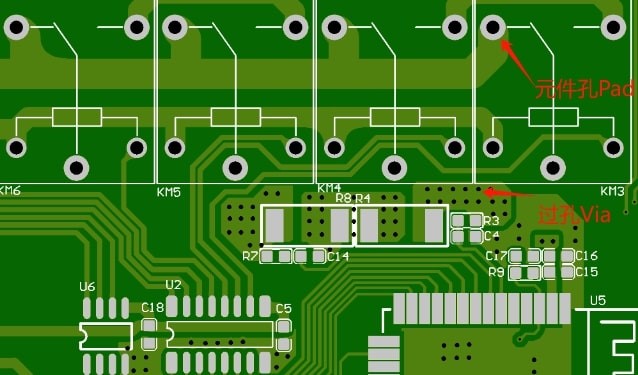Vias are an important part of multilayer PCBs, PCB vias are conductive channels used to connect different layers of copper foil lines. Usually multi-layer structure, common such as double-layer board, four-layer board, and even up to dozens of layers. Between these layers, the vias play the role of conductive bridge. It is by drilling holes in the circuit board, and then in the hole wall copper plating and the formation of the conductive channel. The shape of the vias can be round, oval, etc., but the most common is round.
PCB over-hole from the process can be divided into three categories: blind vias, buried vias and through vias.
Blind Vias:
Blind vias are a kind of through-hole that connects only the surface layer of the PCB and a layer in the middle, and it does not penetrate the entire PCB. therefore, blind vias are very practical in multilayer board design, especially in high-density interconnect (HDI) design can save space. However, since the drilling process for blind vias is more complex, they are more costly compared to through-holes.
Buried Vias:
Buried vias are completely hidden within the layers of the PCB and connect two or more internal copper layers of the PCB. Ideal for high density PCBs with high space constraints.
Through via:
Through-holes are the most common type of through-hole in PCBs. It is created by drilling a hole in the PCB and filling it with an electrically conductive material such as copper.
Through vias are typically used to connect components to other layers of the PCB and to provide structural support. Through vias are drilled from the top to the bottom of the PCB. When you expose a bare PCB to the sun, the through-hole allows sunlight to pass through.

PCB Via
PCB Through via Functions
Signal Routing:
A large number of PCBs use through vias for signal routing. Thicker boards use buried or blind vias and lighter boards use microvias.
Power Wiring:
Blind vias can also be used, but through-holes in most PCB boards are limited to wide vias for power and ground network routing.
Escape routing:
Larger surface mount (SMT) components mostly use through-holes for escape routing. Microvias or blind vias are most commonly used for escape routing, but in-pad vias can be used for solid packages such as high pin count BGAs.
Connections
Through-holes or blind vias can be used to provide multiple connections to a flat surface. For example, a strip of metal with sewn-in vias around a circuit-sensitive area connects it to the ground plane to provide EMI protection.
Thermal Conduction
Through-holes can be used to conduct heat outward from a component through the internal plane layer to which it is connected. Typically, thermal vias require a dense concentration of blind or through vias, where these vias must be located in the solder pads of these devices.
What is the difference between a PCB Via and a PCB Pad?
In PCBs, vias are categorized as Via and Pad and must not be mixed. Vias generally play the role of two-sided conduction, the process is usually selected to cover the oil treatment. Pads is usually designed as plug-in holes, used in plug-in soldering. If the mixed use of Via and Pad, one situation is that the Via attribute is mistakenly used as a Pad in the plug-in package. In one case, the Via property is mistakenly used as a Pad in the plug-in package. When you select the Via Cover Oil, the plug-in hole will be covered or blocked by the ink, and the size cannot be effectively controlled. Another situation is mistakenly used as a Pad as a hole, then the software automatically closes the window of the hole, can not be effectively recognized, which will lead to the need to cover the oil over the hole can not cover the oil.